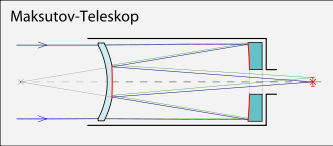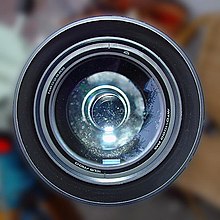Maksutov telescope

The Maksutov reflector is a telescopic construction named after the Russian optician Dmitri Maksutov . It is also used as a telephoto lens. The Maksutov telescope is usually designed with a Cassegrain beam path and is then similar to the Schmidt-Cassegrain telescope . Like this one, it has a spherical primary mirror that is pierced in the middle. Maksutov-Newtonian telescopes derived from the Newtonian telescope are less common. The pure Maksutov telescope, like the pure Schmidt telescope , can only be used as an astro camera because the focus is inside the tube. The combination of lenses and mirrors makes it a catadioptric system . Although this principle is named after Maksutov, it was discovered a little earlier independently of Kurt Penning and Albert Bouwers.
The English spelling “Maksutov Telescope” has also established itself in the German-speaking world, even if the spelling “Maksutov Telescope” would be correct according to the official German transcription rules.
A meniscus-shaped lens, which corrects the spherical aberration of the main mirror, sits at the front tube opening . It also carries the secondary mirror. If it is vapor-deposited on the back of the lens, the construction is called Gregory-Maksutov. This lens, also called the correction plate , is bent, but has an almost constant thickness over the entire surface. The color error of the meniscus lens is therefore extremely small. Since their optically effective surfaces, like the main and secondary mirrors, are spherical, the manufacture of the optics for a Maksutov telescope is significantly easier than for other types of telescopes. Nevertheless, the quality of these optics is not surpassed by any other system in smaller telescopes. The construction is very short. The only disadvantage is the great weight of the thick correction plate.
For focusing, the main mirror is moved axially with a screw that is led out of the telescope at the rear end.
The largest telescopes in this design are located in the following observatories :
- Cerro El Roble , (AZT-16) with an aperture (opening) of 700 mm, double meniscus, the optics were made by Maksutov himself.
- Abastumani Observatory , aperture 700 mm
- Crimean observatory , aperture 650 mm
The HRSC camera of the Mars Express Mars probe has a Maksutov-type lens called SRC (Super Resolution Channel), which was manufactured by Zeiss. This has an aperture of 100 mm and a focal length of 1000 mm.
There are a number of Maksutov telescope manufacturers. The MENISCAS 150/2250 and the MENISCAS 180 from Carl Zeiss in Jena are known. Both devices are no longer produced. Today, various Russian, Japanese and Chinese manufacturers offer Maksutov telescopes for amateur astronomy.
The optical arrangement described has recently also been very popular with mirror lenses for 35 mm cameras because it has a large usable image field. There are lenses with focal lengths of 500, 750 and 1000 mm. Devices of this type come from the countries of the CIS in various designs, sometimes also for the medium format 6 × 6 cm. In contrast to pure telescope optics according to Maksutow, with telephoto lenses the focus after the main and counter mirror is still in the tube. With a lens group that extends the focal length , the focus is shifted so far back that it falls on the film plane of an attached camera. The focal length of the system is usually doubled.
With an adapter, such telephoto lenses in Maksutov design can also be used as very compact telescopes. For example, adapters are used that allow the connection of commercially available eyepieces with a plug diameter of 1¼ ″ (31.75 mm). The best-known example of such a conversion is the telephoto lens "MC MTO-11CA" from Russian production with 1000 mm focal length and 100 mm aperture, often affectionately referred to as the Russian barrel in specialist circles .
With the so-called Field Maksutov reflector, a variant has now been developed in which the meniscus lens is no longer in front of the tube opening, but behind the secondary mirror. This system was developed by the Australian amateur astronomer Ralph W. Field in 1981.
The Russian Juri A. Klewzow had been working on a similar idea since 1974. In his solution, he placed two meniscus lenses in front of the secondary mirror and one meniscus lens in front of the Mangin secondary mirror , known as the Klevtsov telescope .
literature
- Rolf Riekher: Telescopes and their masters . 2nd Edition. Verlag Technik GmbH, Berlin 1990 pp. 338-347 ISBN 3-341-00791-1
Web links
- E. Trigubov, Y. Petrunin: Dimitris Maksutov: The Man and his Telescopes (English; PDF; 2.51 MB)
- Kinds of Telescopes (English)
- Russian Maksutov Intes Alter Micro M603
Individual evidence
- ↑ Kurt Penning: Optical mirror system for generating real images , March 9, 1941
- ↑ Albert Bouwers: CORRECTED SCHMIDT TYPE OPTICAL , Patent, Priority 7 July 1941


